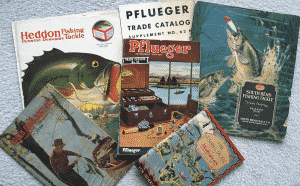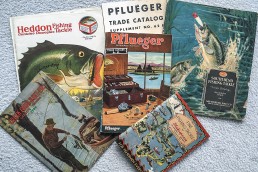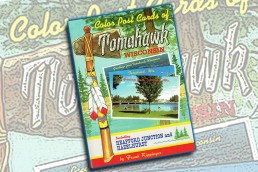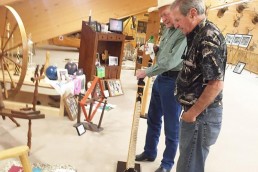Makers’ Catalogs Hold History
SHARE THIS POST
As reported, South Bend offered over 300 reel models, making it impossible to acquire them all. However, if you have access to the early makers’ catalogs, one can enjoy seeing all the tackle they made.
Attending sports shows at an early age and hungrily collecting literature from many exhibitors was the beginning of our accumulation. Many magazines had ads that urged those interested to write for a catalog. Some charged as much as 25 cents to ensure only serious buyers requested one. These efforts expanded as income and interest increased. Big boosts occurred as collections were acquired—it’s a joy to review them as we marvel at the beauty and breadth of their products.

While all catalogs are desirable, the ones for wholesalers and retailers, known as “Trade Catalogs,” are cherished and informative. Some are very extensive, with up to 192 pages of products.
The first of the big five catalog makers is the Creek Chub Bait Company. Their first few catalogs only consisted of a couple pages covering the few lures they offered early on starting in 1916. By the 1930s, their catalog was up to 36 pages. In addition to beautiful photographs of their lures, they provided fishing information and prizes of products worth up to $6,000. For special requests, direct orders were fulfilled for a wide variety of hooks on their lures, including barbless. They also informed the public that their mouthpiece was designed so the screw holding it in place could be removed to reinsert it upside down, making it a wiggling surface bait. Creek Chub also carried rods, reels, line and other items by various companies.
By the 1920s, Heddon offered a full line of bamboo rods, reels, line and an extensive number of fly and baitcasting lures. Their sales messages were superb, even for today. For example: “The Heddon idea started with the belief that the hours of sport are almost the most precious hours of all. We felt that there are all too few of them to risk having equipment that always makes us afraid it’s going to fail us at a critical moment. Doesn’t it seem that making sure that our hours of sport shall have their best chance is about the least we should do?” Hints on baitcasting, fly fishing and fish identification were beautifully produced. Their illustrations of lures made one lust after each one, even though a large wood muskie lure with glass eyes in a beautiful box with a small catalog cost as much as $1.50.
Pfluger’s Trade Catalog number 62 contained an award by the Brand Names Foundation for 50 years of public service. It was an extensive offering consisting of 192 pages plus Supplement 62 B with 15 additional pages. Saltwater reels and hooks of many sizes, including special shark models with chain leaders, were illustrated. Lures start on page 58 and go through page 108. Jack Carter is shown with his rod and reel and two world-record blue fin tuna at 825 and 880 pounds. Lines, terminal tackle, various jars of pork rind, Shoo-Fly repellent, fly dressings and 10-plus pages of bobbers keep one in awe.
Shakespeare is no exception with their extensive offerings. Started in 1879, their 1936 catalog has 38 pages of reels, 13 pages of line, 27 pages of lures and 30 pages of rods. Then there are tackle boxes, minnow buckets, landing nets and more. Their Worm Magnet at $1.65 had an electric plug and metal rod, that when shoved in the ground, produced dialectic strength of 10,000 volts when dry and 1,500 volts after 10 hours of submersion in water. Worms were subsequently brought to the surface as fast as they could travel, making digging unnecessary. As added protection, they recommend wearing rubber boots.
Are you enjoying this post?
You can be among the first to get the latest info on where to go, what to use and how to use it!
The South Bend Bait Company catalog in 1926 contained 120 pages. Again, it contains reels, rods and lines, 69 pages of lures, plus bobbers and terminal tackle. There are also four-color picture slides to use in stores or in your local theater.
Some of the colorful cards of bobbers, box displays of tackle assortments, counter cards of lures by the dozens and large heavy cardboard colorful displays by these companies are very desirable. Most were destroyed after use. However, I did find several that had been laid stacked on an attic floor for insulation.
What beautiful treasures these are, and part of our fishing history.
Dan Basore is a fishing historian and steward of the history of the sport. In his efforts to preserve fishing history, Basore is always on the lookout for information about early lure makers, old lures, pre-level wind reels, manufacturer catalogs, tournament casting items and the like. If you possess information or materials that can help, please contact Dan Basore, Historical Fishing Display, at 630-393-3474 or 1-800-347-4525.
MWO
SHARE THIS POST
Did you enjoy this post?
You can be among the first to get the latest info on where to go, what to use and how to use it!
Dan Basore
Dan Basore is a fishing historian and steward of the history of the sport. In his efforts to preserve fishing history, he is always on the lookout for information about early lure makers, old lures, pre-level wind reels, manufacturer catalogs, tournament casting items and the like. If you possess information or materials of this kind, please contact him at 630-393-3474 or by email at ollures@aol.com.



